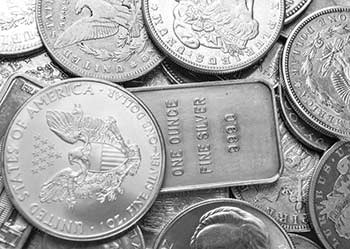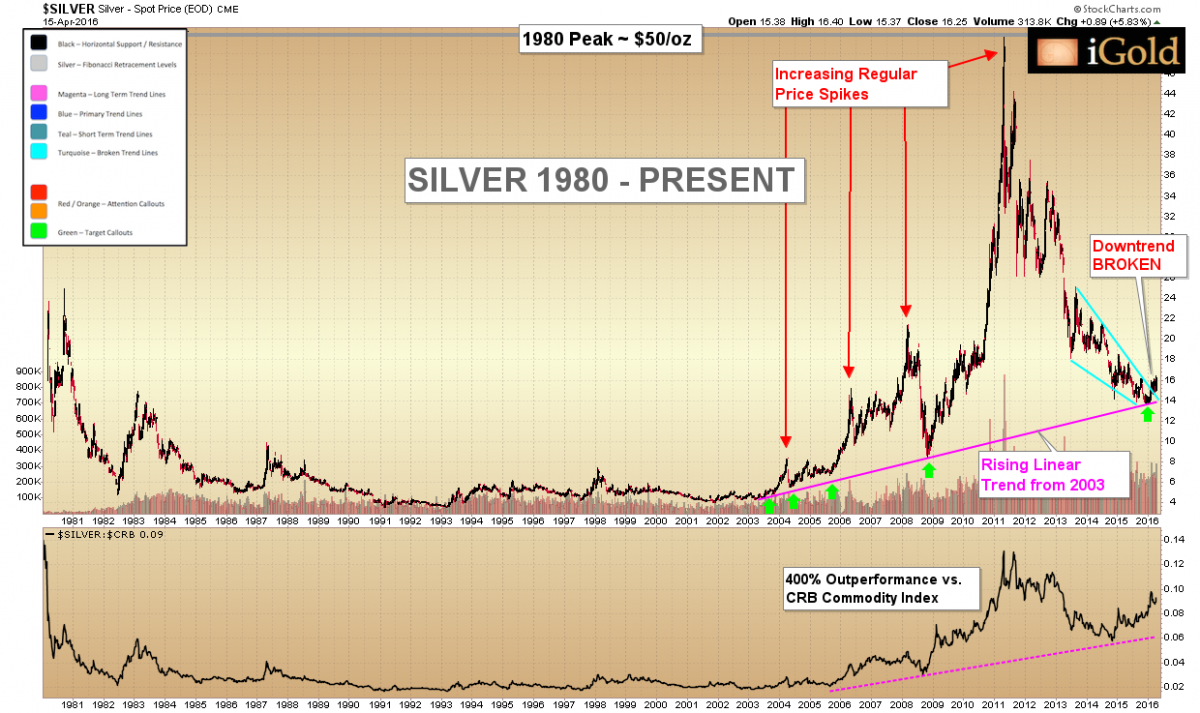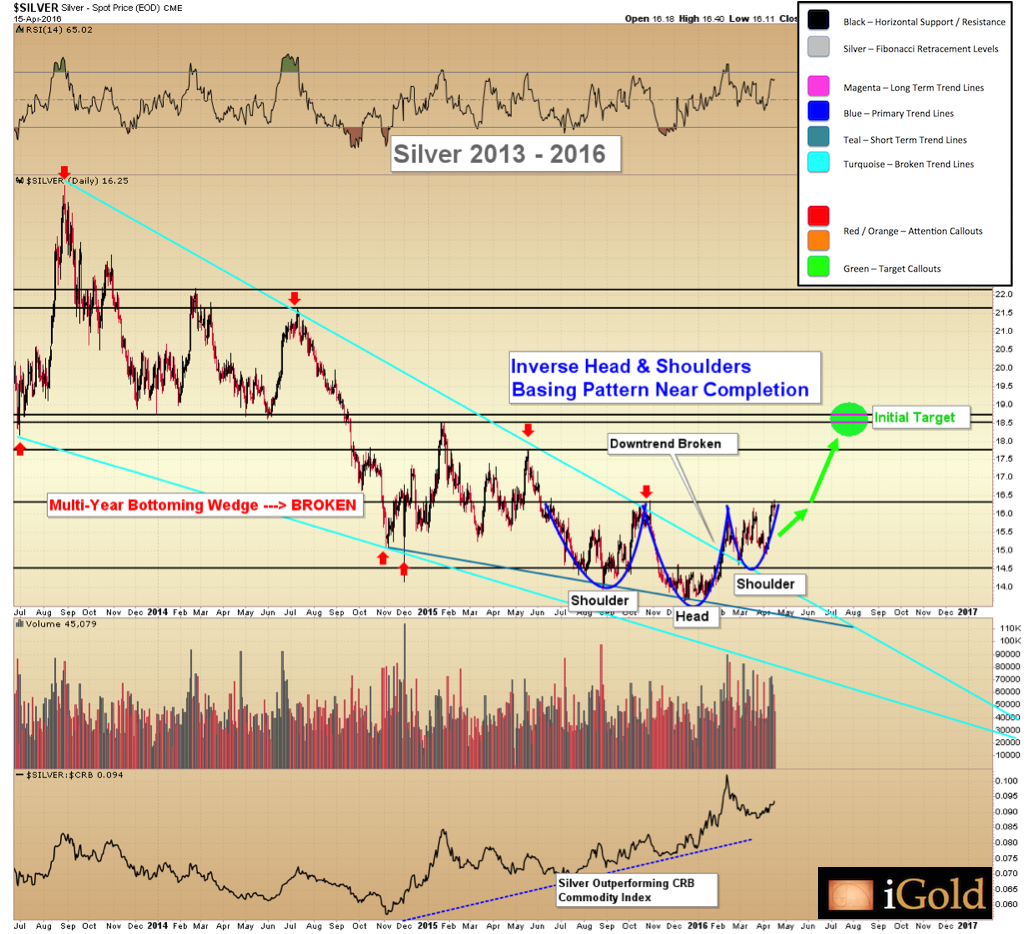Silver Price Forecast And Analysis On Recent Price-Fixing
 News out of Reuters on Wednesday has caused quite a stir in the precious metals investment world as a manipulative silver-fixing scheme headed by large multinational banks was revealed. Consequently, many are wondering what the long-term ramifications of the story will be. To bring readers up to speed, we quote briefly below:
News out of Reuters on Wednesday has caused quite a stir in the precious metals investment world as a manipulative silver-fixing scheme headed by large multinational banks was revealed. Consequently, many are wondering what the long-term ramifications of the story will be. To bring readers up to speed, we quote briefly below:
"Deutsche Bank to Settle US Silver Price-Fixing Litigation
Deutsche Bank AG has agreed to settle U.S. litigation over allegations it illegally conspired with Bank of Nova Scotia and HSBC Holdings Plc to fix silver prices at the expense of investors, a court filing on Wednesday showed.
Terms were not disclosed, but the accord will include a monetary payment by the German bank, a letter filed in Manhattan federal court by lawyers for the investors said.
Deutsche Bank has signed a binding settlement term sheet, and is negotiating a formal settlement agreement to be submitted for approval by U.S. District Judge Valerie Caproni, who oversees the litigation.
A Deutsche Bank spokeswoman declined to comment. Lawyers for the investors did not immediately respond to requests for comment.
Investors accused Deutsche Bank, HSBC, and ScotiaBank of abusing their power as three of the world's largest silver bullion banks to dictate the price of silver through a secret, once-a-day meeting known as the Silver Fix.
According to the lawsuit, the defendants distorted prices on the roughly $30 billion of silver and silver financial instruments traded annually, violating U.S. antitrust law."
Watch This Story Closely
There are a number of intricacies to this story, and indeed, we do not know exactly how this is going to reverberate throughout the markets yet, but this development bears watching over the months ahead if you have been involved in the precious metals markets over the last 15 years.
To further this story, it should be known that a class action lawsuit seeking $1 billion in damages has just been filed on behalf of Canadian investors against the banks. Please see the link below for more information on the suit. I would encourage anyone living in Canada to learn more about becoming a plaintiff if you have suffered any material losses since 2000 in the precious metals market:
http://www.sotosllp.com/class-actions/current-cases/silver-manipulation
Such lawsuits are likely to follow soon in the United States, but it is unclear to what extent the lawsuits will seek compensation. As an example, will the suits cover damages caused to gold and silver mining companies or investors of mining companies? Will the proceeds be distributed evenly to all plaintiffs, or will they be prorated based on demonstrated losses?
The ramifications of this development are significant, as many individuals lost large sums during the decline in prices from 2011 - 2015. Of course, not all of these declines were caused by the banks, as market forces exerted some impact on prices as well. How will the lawsuits attempt to prove which losses were the result of manipulation versus normal market action? Much is still to be determined.
Our Response to the Story
First, as a matter of record, I served as a witness to the plaintiffs in this trial some months ago. The conversation with the attorney consisted mostly of fact-gathering as to the technical workings of the silver market. My only knowledge of the manipulation in question came from my experience observing the price action in the markets, and what I had heard rumored through certain discussion forums. I still am unsure how the plaintiffs found my contact information. Nonetheless, it was a fascinating discussion.
I have long held the belief that manipulation happens across nearly all markets. A prime example is insider trading in stocks. Exact determinations of how often this practice happens are impossible to know, but anyone who spends sufficient time trading and observing price patterns in stocks knows that it does happen often. Regulators are lucky if they can catch 1 out of 100 instances.
Once in a rare occasion, when regulators catch such trading, they will launch a full prosecution and seek significant jail time for the offenders. The rest of the time, penalties are less harsh and include a fine. Similar to tax evasion, regulators know they cannot feasibly catch all the perpetrators, so their main strategy is deterrence.
It is not at all surprising to confirm that manipulation does happen in the precious metals market. What is more surprising is that regulators chose to pursue this particular instance for prosecution, especially because the silver market is so small and with minuscule political backing compared to other major world markets.
Markets Always Win Out
So, manipulation happens in the precious metals -- as it does in nearly all markets.
Yet at the same time, we must remember that all markets are stronger than any attempts to hold them back. We see this over and over again throughout history -- markets win out in the end. Indeed, if the precious metals could be manipulated forever, gold would still be $255 per ounce as it was in the year 2001. Clearly, the manipulation happens over the short run in an attempt to gain trading profits, but it is ineffective over a long timeframe. Market forces are always more powerful.
If the markets did not win out in the end, we would not want to be involved in them. The reason we are involved in gold and silver is because we know we can profit over an intermediate or long-term time horizon through proper investing.
How Will This Settlement Affect Precious Metals Prices?
That is unclear. Neither gold nor silver showed any immediate reaction to the news.
It is conceivable that some parties who formerly held gold and silver bullion in custody with the aforementioned banks might lose trust in them. Some parties might even switch from holding paper contracts to private physical storage, which would put upward pressure on the physical bullion market.
Whatever settlement is handed down to the banks is unlikely to be more than a slap on the wrist when compared to the balance sheets of these institutions. And ultimately, if there are profits to be made from manipulative trading in the precious metals, rest assured that the banks will find other ways to go about taking them, whether they need to use intermediaries or offshore accounts, the banks will eventually return to these markets.
In the short run, it will be interesting to watch the volume patterns of contracts traded in both gold and silver over the next few months. If volume shrinks even as prices rise, it would indicate that some of the parties formerly involved in these tactics are becoming more cautious, choosing to let the dust clear for some time.
In such an instance, especially if coinciding with organic new physical demand perhaps related to a weakening US stock market, we might very well see new gold and silver buying generally unopposed by paper short sales. Such could add fuel to the fire for rising gold and silver price trends we anticipate over the months to come.
In summary, I would urge you to pay attention to this story in the months ahead. We may see new physical buying demand begin to emerge, and we may see upward pressure on prices as a result. And if there is a possibility of receiving some compensation from the class action, I would encourage you to seek the maximum amount that the law allows.
Update on Silver Prices
Silver bucked the weakness in gold last week and closed at $16.25 per ounce, up nearly 89 cents or 5.8% for the week. Such a divergence is notable, especially in light of silver's underperformance relative to gold over the last few years. Silver investors, who have grown accustomed to seeing silver fall with gold but fail to rise alongside its close cousin, are seeing early clues that this underperformance is in the process of changing.
Indeed, more data is coming in about the final leg of the complex bottoming pattern we have seen in silver since 2013. We can observe this more clearly now as the Inverse Head & Shoulders pattern is becoming quite apparent to those familiar with such technical studies. (For those unfamiliar with the technical pattern, imagine the silhouette of a person -- two shoulders with the head sticking out more prominently -- and then flipping this person upside down.) This is outlined below in royal blue for your observation.
The resistance level to watch to confirm this pattern happens to be exactly where prices ended on Friday: $16.25. Once prices break decisively through this level, we expect to see a large wave of new buyers enter the market, and for silver to reach $18.50-75 quickly as an initial target.
These new buyers will consist of those who either shorted silver at lower prices and are forced to cover those sales or who failed to buy silver up to this point -- and now become more certain that waiting further is not a wise choice.
We continue to recommend that long-term silver bullion investors use any remaining weakness near the $15 level to finalize purchases at or near these long-term lows. Over the long run, any purchases below $18.50 will be seen as excellent value for the move we expect to unfold in the next five years, which should see a re-challenge of the important $50 level.
********




















